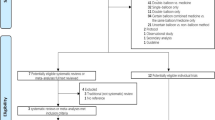Abstract
Objective
To assess the efficacy and safety of a double-balloon catheter versus dinoprostone insert for labour induction.
Study design
PubMed, MEDLINE, Embase, ClinicalTrials.gov, and the Cochrane Central Register of Clinical Trials databases were searched from 1985 to April 2018. Randomized controlled trials that compared a double-balloon catheter and dinoprostone insert for cervical ripening were identified. Eligible study populations consisted of women with singleton pregnancies that had any indication for labour induction and were randomly assigned to undergo induction with a double-balloon catheter or dinoprostone insert. The main outcomes were incidence of vaginal delivery within 24 h and caesarean section, and neonatal outcomes.
Results
Five randomized trials (603 women; 305 with a double-balloon catheter and 298 with a dinoprostone insert) were eligible for inclusion. No differences were observed between the two groups in terms of vaginal delivery within 24 h [relative risk (RR) 1.21, 95% confidence interval (CI) 0.93–1.59] and incidence of caesarean section (RR 0.99, 95% CI 0.77–1.27). Compared with the double-balloon catheter, the dinoprostone insert was associated with a reduced need for oxytocin administration in the process of labour induction (RR 1.95, 95% CI 1.45–2.62). However, there was a higher incidence of excessive uterine activity (RR 0.17, 95% CI 0.06–0.54) and neonatal umbilical cord arterial blood pH < 7.1 (RR 0.36, 95% CI 0.15–0.84) in the dinoprostone insert group.
Conclusion
This review showed that the efficacy of labour induction using both the double-balloon catheter and dinoprostone insert was similar. However, the double-balloon catheter seemed to be a safer method.




Similar content being viewed by others
References
Osterman MJ, Martin JA (2014) Recent declines in induction of labor by gestational age. NCHS Data Brief 155:1–8
Edwards RK, Szychowski JM, Berger JL, Petersen M, Ingersoll M, Bodea-Braescu AV, Lin MG (2014) Foley catheter compared with the controlled-release dinoprostone insert: a randomized controlled trial. Obstet Gynecol 123(6):1280–1287. https://doi.org/10.1097/AOG.0000000000000238
Lokkegaard E, Lundstrom M, Kjaer MM, Christensen IJ, Pedersen HB, Nyholm H (2015) Prospective multi-centre randomised trial comparing induction of labour with a double-balloon catheter versus dinoprostone. J Obstet Gynaecol 35(8):797–802. https://doi.org/10.3109/01443615.2015.1011101
Kehl S, Weiss C, Wamsler M, Beyer J, Dammer U, Heimrich J, Faschingbauer F, Sutterlin M, Beckmann MW, Schleussner E (2016) Double-balloon catheter and sequential vaginal prostaglandin E2 versus vaginal prostaglandin E2 alone for induction of labor after previous cesarean section. Arch Gynecol Obstet 293(4):757–765. https://doi.org/10.1007/s00404-015-3907-7
Lim CE, Ng RW, Xu K (2013) Non-hormonal methods for induction of labour. Curr Opin Obstet Gynecol 25(6):441–447. https://doi.org/10.1097/GCO.0000000000000027
Jozwiak M, Oude Rengerink K, Benthem M, van Beek E, Dijksterhuis MG, de Graaf IM, van Huizen ME, Oudijk MA, Papatsonis DN, Perquin DA, Porath M, van der Post JA, Rijnders RJ, Scheepers HC, Spaanderman ME, van Pampus MG, de Leeuw JW, Mol BW, Bloemenkamp KW, Group PS (2011) Foley catheter versus vaginal prostaglandin E2 gel for induction of labour at term (PROBAAT trial): an open-label, randomised controlled trial. Lancet 378(9809):2095–2103. https://doi.org/10.1016/s0140-6736(11)61484-0
Levy R, Kanengiser B, Furman B, Ben Arie A, Brown D, Hagay ZJ (2004) A randomized trial comparing a 30-ml and an 80-ml Foley catheter balloon for preinduction cervical ripening. Am J Obstet Gynecol 191(5):1632–1636. https://doi.org/10.1016/j.ajog.2004.03.033
Salim R, Zafran N, Nachum Z, Garmi G, Kraiem N, Shalev E (2011) Single-balloon compared with double-balloon catheters for induction of labor: a randomized controlled trial. Obstet Gynecol 118(1):79–86. https://doi.org/10.1097/AOG.0b013e318220e4b7
Kehl S, Ziegler J, Schleussner E, Tuschy B, Berlit S, Kirscht J, Hagele F, Weiss C, Siemer J, Sutterlin M (2015) Sequential use of double-balloon catheter and oral misoprostol versus oral misoprostol alone for induction of labour at term (CRB plus trial): a multicentre, open-label randomised controlled trial. BJOG 122(1):129–136. https://doi.org/10.1111/1471-0528.13116
Chen W, Xue J, Peprah MK, Wen SW, Walker M, Gao Y, Tang Y (2016) A systematic review and network meta-analysis comparing the use of Foley catheters, misoprostol, and dinoprostone for cervical ripening in the induction of labour. BJOG 123(3):346–354. https://doi.org/10.1111/1471-0528.13456
Liu A, Lv J, Hu Y, Lang J, Ma L, Chen W (2014) Efficacy and safety of intravaginal misoprostol versus intracervical dinoprostone for labor induction at term: a systematic review and meta-analysis. J Obstet Gynaecol Res 40(4):897–906. https://doi.org/10.1111/jog.12333
Cromi A, Ghezzi F, Uccella S, Agosti M, Serati M, Marchitelli G, Bolis P (2012) A randomized trial of preinduction cervical ripening: dinoprostone vaginal insert versus double-balloon catheter. Am J Obstet Gynecol 207(2):125. https://doi.org/10.1016/j.ajog.2012.05.020 (e121-e127)
Suffecool K, Rosenn BM, Kam S, Mushi J, Foroutan J, Herrera K (2014) Labor induction in nulliparous women with an unfavorable cervix: double balloon catheter versus dinoprostone. J Perinat Med 42(2):213–218. https://doi.org/10.1515/jpm-2013-0152
Shechter-Maor G, Haran G, Sadeh-Mestechkin D, Ganor-Paz Y, Fejgin MD, Biron-Shental T (2015) Intra-vaginal prostaglandin E2 versus double-balloon catheter for labor induction in term oligohydramnios. J Perinatol 35(2):95–98. https://doi.org/10.1038/jp.2014.173
Du C, Liu Y, Liu Y, Ding H, Zhang R, Tan J (2015) Double-balloon catheter vs. dinoprostone vaginal insert for induction of labor with an unfavorable cervix. Arch Gynecol Obstet 291(6):1221–1227. https://doi.org/10.1007/s00404-014-3547-3
Wang W, Zheng J, Fu J, Zhang X, Ma Q, Yu S, Li M, Hou L (2014) Which is the safer method of labor induction for oligohydramnios women? Transcervical double balloon catheter or dinoprostone vaginal insert. J Matern Fetal Neonatal Med 27(17):1805–1808. https://doi.org/10.3109/14767058.2014.880880
Funding
This study was not funded.
Author information
Authors and Affiliations
Contributions
YL: Project development, data collection, data analysis, manuscript writing/editing. CP, XW: Data collection, data analysis. XW: Project development, data analysis, manuscript editing.
Corresponding author
Ethics declarations
Conflict of interest
The authors declare that they have no confict of interest.
Ethical approval
This article does not contain any studies with human participants or animals performed by any of the authors.
Rights and permissions
About this article
Cite this article
Liu, YR., Pu, CX., Wang, XY. et al. Double-balloon catheter versus dinoprostone insert for labour induction: a meta-analysis. Arch Gynecol Obstet 299, 7–12 (2019). https://doi.org/10.1007/s00404-018-4929-8
Received:
Accepted:
Published:
Issue Date:
DOI: https://doi.org/10.1007/s00404-018-4929-8




